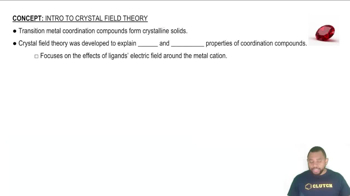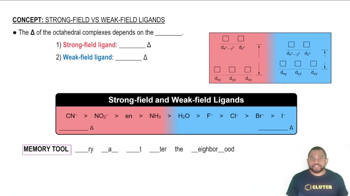Here are the essential concepts you must grasp in order to answer the question correctly.
Crystal Field Theory
Crystal Field Theory (CFT) explains how the arrangement of ligands around a central metal ion affects the energy levels of its d orbitals. In an octahedral complex like [Cr(H₂O)₆]²⁺, the d orbitals split into two energy levels: the lower-energy t₂g and the higher-energy e_g orbitals. This splitting is crucial for understanding the electronic configuration and magnetic properties of the complex.
Recommended video:
The study of ligand-metal interactions helped to form Ligand Field Theory which combines CFT with MO Theory.
Electron Configuration
The electron configuration of an atom describes the distribution of electrons among the various atomic orbitals. For transition metals, this involves the d orbitals, which can hold up to ten electrons. In the case of [Cr(H₂O)₆]²⁺, chromium loses two electrons from its 3d orbitals, resulting in a configuration that influences the number of unpaired electrons and the overall magnetic behavior of the complex.
Recommended video:
Electron Configuration Example
Ligand Field Strength
Ligand field strength refers to the ability of ligands to influence the energy levels of the d orbitals in a metal complex. Strong field ligands, like CN⁻, cause a larger splitting of the d orbitals, while weak field ligands, like H₂O, result in smaller splitting. The nature of the ligands affects the number of unpaired electrons and the magnetic properties of the complex, which is essential for drawing the correct energy-level diagram.
Recommended video:
Strong-Field Ligands result in a large Δ and Weak-Field Ligands result in a small Δ.

 Verified step by step guidance
Verified step by step guidance

